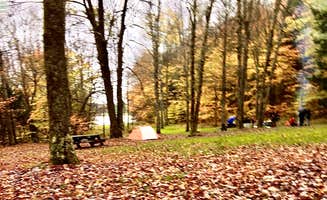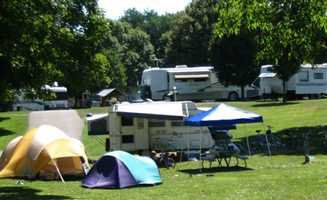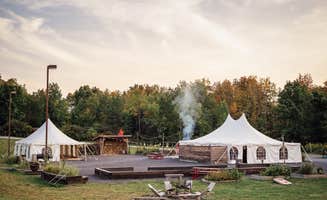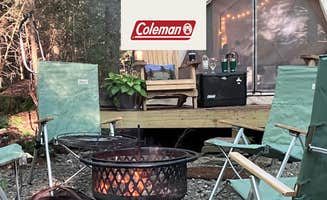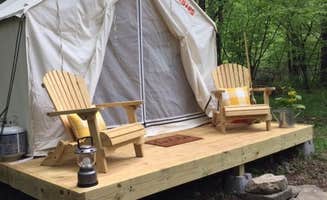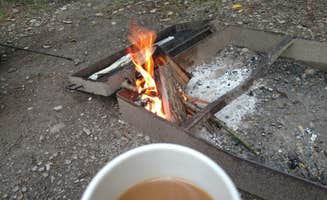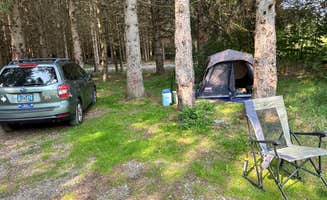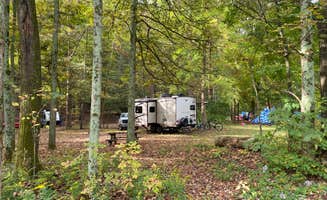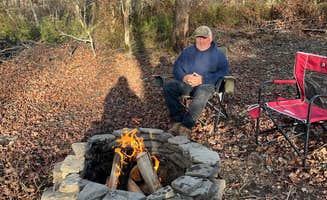Camping options near Berkshire, New York extend throughout the Southern Tier region, situated at elevations ranging from 800 to 1,200 feet above sea level. Winter temperatures typically drop below freezing from December through March, with summer averages reaching the mid-80s. Most campgrounds operate within a 30-mile radius of Berkshire, creating convenient access to the Finger Lakes region and numerous state forests.
What to do
Swimming in natural settings: Robert H. Treman State Park Campground offers a unique swimming experience beneath a waterfall. "The swimming is excellent, lots of space for everyone, and they have lifeguards on duty just in case," notes one visitor about nearby Greenwood County Park. The natural swimming areas provide alternatives to traditional pool facilities.
Hiking varied terrain: The region features numerous trails suitable for different ability levels. "Everyone says how great the water falls are. And yes they are. But this is truly a great place to camp. From the wilderness sites and nice bath houses to the hiking trails," shares a reviewer about Robert H. Treman State Park Campground. Many trails follow gorges or connect multiple water features.
Winter recreation: Unlike most seasonal campgrounds, some locations remain open year-round. "Beautiful oasis of a park near the hamlet of Lisle. Really enjoyed the miles of hiking trails which are supposedly also great from snowshoeing and cross country skiing in the winter," notes a Greenwood County Park visitor. These winter activities allow for extended camping seasons beyond the typical May-October window.
What campers like
Natural swimming holes: The region's swimming areas differ from typical campground pools. At Watkins Glen State Park Campground, "Campers arriving at Watkins Glen State Park are immediately captivated by its dramatic gorge scenery, where 19 waterfalls cascade through narrow stone walls." These water features create unique recreational opportunities throughout the summer months.
Diverse camping loops: Many campgrounds offer distinctly different camping areas within the same facility. "Site 54 at Robert H Treman is very large, flat, nonelectric and well shaded with areas of sun. A long walk to the restroom. The new loop is a large field--we got one of the few shady sites in the new loop. Old loop has plenty of trees, but sites are much smaller," explains one camper.
Off-season solitude: Fall and winter camping receives high marks from experienced campers. "This was my first time visiting Greenwood County Park and I was pleasantly surprised. Your camping and recreation options are definitely better in the 'off' season because hardly anyone was here, but the fall colors were absolutely spectacular!" writes one reviewer.
What you should know
Campsite selection matters: At Chenango Valley State Park Campground, "Parking pads in the non-electric section are dirt/grass. Some of the pads are short; this section is geared toward tent campers. We found a site long enough to easily accommodate our vehicle and teardrop trailer (30 ft total)." Research specific loops and sites before booking.
Wildlife encounters: Local wildlife can affect camping experiences. "Beware of raccoons. They are brazen thieves here...and every campground they inhabit. Just don't leave your food out," warns a Chenango Valley camper. Some campgrounds also note occasional bear activity.
Road noise variations: Some campgrounds experience more road noise than others. "The only drawback to this campground is the close proximity of the noisy highway but great for a one night stay or longer if you're accustomed to the noise," notes a visitor to Hickories Park. Sites farther from main roads typically provide quieter experiences.
Tips for camping with families
Water recreation focus: Family-friendly swimming areas receive particular praise. At Pine Valley RV Park & Campground, "So many things for kids to do. From boating, to giant swimming inflatables, putt putt even a giant slide. All part of the price of the campground," notes one family visitor. These inclusive amenities eliminate additional activity costs.
Playground access: Many campgrounds offer dedicated play structures. "They have a huge new playground for the kids and lots of area to walk around the loops if you don't want to hike the gorge trail," reports a Watkins Glen visitor. These playgrounds provide activity options during inclement weather or between scheduled recreation.
Fishing opportunities: Several locations include stocked fishing areas. "There are boats available for rent, a waterfront swimming area, great fishing, and lots of trails to hike!" shares a Greenwood County Park visitor. Most waterfront campgrounds permit fishing with appropriate New York State licenses for visitors age 16 and older.
Tips from RVers
Site leveling challenges: Some campgrounds present difficulties for larger rigs. "Beautiful park. Electric sites are not the best though. Rocky and unlevel. Not made for large campers," notes one RVer about Robert H. Treman. Sites at Buttermilk Falls State Park Campground also receive similar comments about accessibility.
Access road conditions: Access roads to some campgrounds present challenges. "The hill you climb to the camp sites is riddled with pot holes," reports a Buttermilk Falls visitor. These conditions can impact both arrival and departure, particularly for larger recreational vehicles.
Loop navigation: Internal campground roads vary in navigability. "The roads within the campground were kind of tight to get through with trees and curves," notes a Watkins Glen visitor who stayed in a 30-foot motorhome. These restrictions may require additional planning or site selection for larger rigs.


